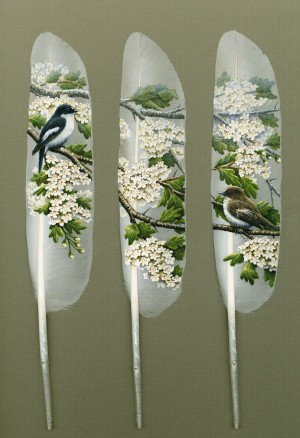Feather Paint Champion
The portrait of nature, an item that is ever ubiquitous in our realm of art. Though at times striking in its meticulous detail and appearance, a work of serene landscapes or majestic flora and fauna can often be easily overlooked by society’s eyes. They populate our restaurants, lobbies, and, owing to their beauty, are found in homes all over the world. So, a challenge for a nature loving artist presents itself: how to stay true to a passion and a vision as well as engage and capture an intrigued audience?
While artist Ian Davie may scorn the old clichéd metaphor of killing two birds with one stone, his work invites fresh air to a realm over canvassed by public access to educational painting shows and art schools. Surrounding himself amongst the most pristine wildlife locales in Britain, his painstaking, delicate paintings elevate the natural world to a new sphere of influence in the art world.
“I find inspiration all around me in these stunning locations which are constantly changing with seasons, weather, and light,” Davie said.
“These areas are the habitats for our rich flora and fauna, which over many years I have gained an understanding and empathy for. I now bring this to bear when creating a painting,” he added.
But what makes his artwork irrevocably unique is not his choice of theme, but that of his canvas — Davie uses swan feathers from a bird reserve.
Specifically desired by the artist for their size, links to the Queen, and for their mythological value, Davie makes a generous donation to the reserve every year in return for the feathers, which are gathered and donated to the artist after the yearly molt. Each feather on average is about three inches wide and a foot long, with some works remarkably spanning several feathers.
Using a specialized acrylic paint that coats and protects the feathers, rather than oil paints which would corrupt it, he skillfully adorns each one with a custom 000-size brush. Yet, according to the former taxidermist, painting on such a surface doesn’t come without its complications.
“Painting directly onto feathers brings with it a number of challenges: extensive feather preparation, sympathetic compositions for a small vertical canvas area, delicate brushwork directly onto the feather, and careful framing,” he said.
Davie’s motivation to use feathers came from a trip he made with his wife Tracy to New Zealand, and was awed by the concept he witnessed from the feather art of the native Maori people of incorporating elements of nature itself into the work. His craft not only utilizes a medium that is sustainable, but also one that is long lasting. According to the scenic artist, he had been told by natural history experts that feathers have been found completely intact inside tombs of Egyptian pharaohs thousands of years old, further fascinating and providing him with self-assurance over his artistic choice.
A late-arriver to the art scene — picking up a brush for the first time at age 40 — Davie, while surprised at his natural talent for painting, was never in doubt about what he wanted to do and what he wanted his work to express.
“Having spent most of my adult life working with wildlife, which I love, it was no great surprise this was the subject I chose to paint,” he said.
He didn’t so much mind the level of attention his work would attain, but specific considerations were thought out to ensure a unique view of his interest and a particular level of equilibrium were achieved for the world he so earnestly cares for.
Critical and popular reaction to his work has been overwhelmingly positive. His unique feather paintings have been exhibited in the Welsh Museum of Modern Art; and in 2009, he was invited to be the artist in residence at the Nature and Art Museum in Gloucestershire. Three of his works have been submitted to the National Exhibition of Wildlife Art (NEWA), and he has received numerous awards, such as the Wildlife Art Society International’s Annual Exhibition of Wildlife Art award this past year. Items available for purchase have gone as high as $2,000. These more pricey designs stem from five large swan feathers spanned like a wing encompassing a single work.
Despite the exception of a description of what the painting contains pertaining to animal and plant life, his work is largely untitled. Laboring in his studio, constructed in a converted farmhouse in the heart of Snowdonia National Park, on a small 70-acre farm in Wales with his wife and their four children, Davie spares no expense fashioning the makeup of the feather itself into the work. A captivating example being Pied flycatchers and Hawthorn Blossom, shades of blue and grey are warmly blended to the barbs and rachis of the feather to make the feather itself seem part of the sky background which engulfs the blossom tree, fabricating a lush and vivid texture that can only truly be appreciated by seeing the piece in person.
With a large family and home to take care of, Davie remains exceptionally busy presently. He states that he continues to perfect his craft with the determined goal of getting better and better. Alluding to the beauty of light as encouragement, Davie has no intention of resting his brush anytime soon.
“This is essence that breathes life into a painting and I am always striving to capture this in my work. I consider the result to be worth every effort,” he said.

